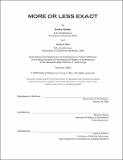| dc.contributor.advisor | Mariana Ibañez. | en_US |
| dc.contributor.author | Földesi, Dalma. | en_US |
| dc.contributor.author | Seo, Jung In, | en_US |
| dc.contributor.other | Massachusetts Institute of Technology. Department of Architecture. | en_US |
| dc.date.accessioned | 2021-02-19T20:16:18Z | |
| dc.date.available | 2021-02-19T20:16:18Z | |
| dc.date.copyright | 2020 | en_US |
| dc.date.issued | 2020 | en_US |
| dc.identifier.uri | https://hdl.handle.net/1721.1/129846 | |
| dc.description | Thesis: M. Arch., Massachusetts Institute of Technology, Department of Architecture, February, 2020 | en_US |
| dc.description | Cataloged from student-submitted thesis. | en_US |
| dc.description | Includes bibliographical references (pages 138-140). | en_US |
| dc.description.abstract | More or Less Exact tests the fidelity of material control by hands, by machines, and by the interaction of the two. We overlap two models of exactitude within the discipline of architecture to expose a design space at their intersection. One model, underlying Western practice since modernism, is based on specifications provided by the architect. Distancing designer and builder, this model locates the 'exact' in dimensional stability. The built outcome always approaches, though never reaches, a geometric ideal through correction and repair in an attempt to deny any material transformations due to the process of construction and the passing of time. The other model finds exactitude in the fidelity of actions that control material. This model incorporates a notion of continuous maintenance, as the building no longer needs to approximate a geometric a priori. Setting these two models in dialogue, More or Less Exact opens up an undervalued design space: rather than optimizing for the more and more exact, we dynamically navigate the liminal space between the two definitions. Learning from techniques of shaping clay--manual and mechanized--, we operate in the space between the two 'exacts' by compounding actions that control material. Relocating precision to the design of tools, we conceive of building as continual process: a sequence of actions performed collaboratively between human and nonhuman agents. | en_US |
| dc.description.statementofresponsibility | by Dalma Földesi and Jung In Seo. | en_US |
| dc.format.extent | 141 pages | en_US |
| dc.language.iso | eng | en_US |
| dc.publisher | Massachusetts Institute of Technology | en_US |
| dc.rights | MIT theses may be protected by copyright. Please reuse MIT thesis content according to the MIT Libraries Permissions Policy, which is available through the URL provided. | en_US |
| dc.rights.uri | http://dspace.mit.edu/handle/1721.1/7582 | en_US |
| dc.subject | Architecture. | en_US |
| dc.title | More or less exact | en_US |
| dc.type | Thesis | en_US |
| dc.description.degree | M. Arch. | en_US |
| dc.contributor.department | Massachusetts Institute of Technology. Department of Architecture | en_US |
| dc.identifier.oclc | 1236890156 | en_US |
| dc.description.collection | M.Arch. Massachusetts Institute of Technology, Department of Architecture | en_US |
| dspace.imported | 2021-02-19T20:15:17Z | en_US |
| mit.thesis.degree | Master | en_US |
| mit.thesis.department | Arch | en_US |
